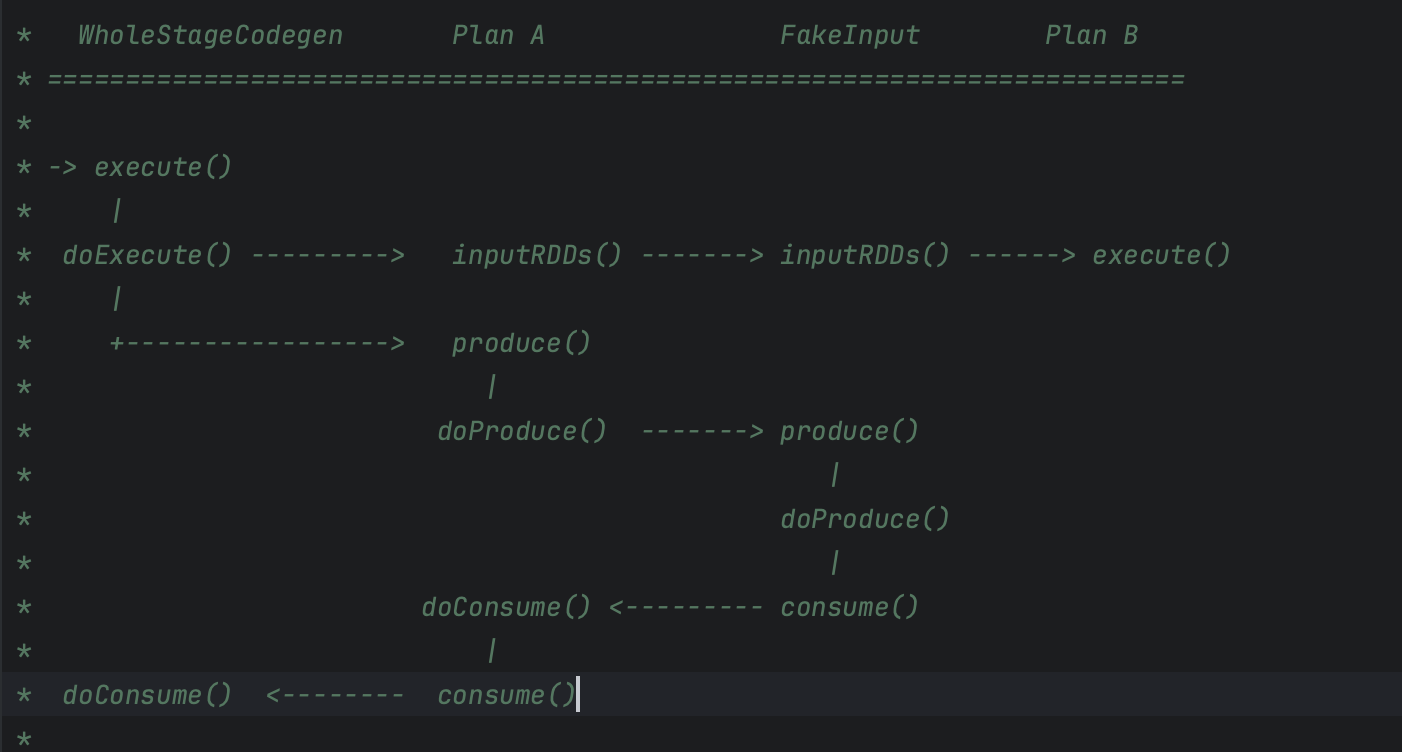15721这一章没什么好说的,不再贴课程内容了。codegen和simd在工业界一般只会选一种实现。比如phothon之前用codegen,然后改成了向量化引擎。一般gen的都是weld IR/LLVM IR/当前语言,gen成C++的也要检查是不是有本地预编译版本,要不没法用。因为clickhouse没有codegen,这节课就拿我比较熟悉的spark的tungsten来当例子,tungsten会gen成scala,然后拿janino动态编译。
tungsten主要有两个特色:一个是codegen,另一个是in-heap memory的管理。本文顺便把它的内存管理也分析一下。在jvm堆内自由分配内存,不被free,不受gc影响,还是挺有意思的。
WASG
手写代码的生成过程分为两个步骤:
- 从父节点到子节点,递归调用 doProduce,生成框架
- 从子节点到父节点,递归调用 doConsume,向框架填充每一个操作符的运算逻辑

首先,在 Stage 顶端节点也就是 Project 之上,添加 WholeStageCodeGen 节点。WholeStageCodeGen 节点通过调用 doExecute 来触发整个代码生成过程的计算。doExecute 会递归调用子节点的 doProduce 函数,直到遇到 Shuffle Boundary 为止。这里,Shuffle Boundary 指的是 Shuffle 边界,要么是数据源,要么是上一个 Stage 的输出。在叶子节点(也就是 Scan)调用的 doProduce 函数会先把手写代码的框架生成出来。
override def doExecute(): RDD[InternalRow] = {
// 下面这一行将会调用子类的produce完成上述过程。
val (ctx, cleanedSource) = doCodeGen()
// try to compile and fallback if it failed
// 调用janino完成动态编译过程
val (_, compiledCodeStats) = try {
CodeGenerator.compile(cleanedSource)
} catch {
case NonFatal(_) if !Utils.isTesting && conf.codegenFallback =>
// We should already saw the error message
logWarning(s"Whole-stage codegen disabled for plan (id=$codegenStageId):\n $treeString")
return child.execute()
}
// Check if compiled code has a too large function
if (compiledCodeStats.maxMethodCodeSize > conf.hugeMethodLimit) {
logInfo(s"Found too long generated codes and JIT optimization might not work: " +
s"the bytecode size (${compiledCodeStats.maxMethodCodeSize}) is above the limit " +
s"${conf.hugeMethodLimit}, and the whole-stage codegen was disabled " +
s"for this plan (id=$codegenStageId). To avoid this, you can raise the limit " +
s"`${SQLConf.WHOLESTAGE_HUGE_METHOD_LIMIT.key}`:\n$treeString")
return child.execute()
}
val references = ctx.references.toArray
val durationMs = longMetric("pipelineTime")
// Even though rdds is an RDD[InternalRow] it may actually be an RDD[ColumnarBatch] with
// type erasure hiding that. This allows for the input to a code gen stage to be columnar,
// but the output must be rows.
val rdds = child.asInstanceOf[CodegenSupport].inputRDDs()
assert(rdds.size <= 2, "Up to two input RDDs can be supported")
if (rdds.length == 1) {
rdds.head.mapPartitionsWithIndex {
(index, iter) =>
val (clazz, _) = CodeGenerator.compile(cleanedSource)
val buffer = clazz.generate(references).asInstanceOf[BufferedRowIterator]
buffer.init(index, Array(iter))
new Iterator[InternalRow] {
override def hasNext: Boolean = {
val v = buffer.hasNext
if (!v) durationMs += buffer.durationMs()
v
}
override def next: InternalRow = buffer.next()
}
}
} else {
// Right now, we support up to two input RDDs.
rdds.head.zipPartitions(rdds(1)) {
(leftIter, rightIter) =>
Iterator((leftIter, rightIter))
// a small hack to obtain the correct partition index
}.mapPartitionsWithIndex {
(index, zippedIter) =>
val (leftIter, rightIter) = zippedIter.next()
val (clazz, _) = CodeGenerator.compile(cleanedSource)
val buffer = clazz.generate(references).asInstanceOf[BufferedRowIterator]
buffer.init(index, Array(leftIter, rightIter))
new Iterator[InternalRow] {
override def hasNext: Boolean = {
val v = buffer.hasNext
if (!v) durationMs += buffer.durationMs()
v
}
override def next: InternalRow = buffer.next()
}
}
}
}
def doCodeGen(): (CodegenContext, CodeAndComment) = {
val startTime = System.nanoTime()
val ctx = new CodegenContext
val code = child.asInstanceOf[CodegenSupport].produce(ctx, this)
// main next function.
ctx.addNewFunction("processNext",
s"""
protected void processNext() throws java.io.IOException {
${
code.trim}
}
""", inlineToOuterClass = true)
val className = generatedClassName




 最低0.47元/天 解锁文章
最低0.47元/天 解锁文章

















 被折叠的 条评论
为什么被折叠?
被折叠的 条评论
为什么被折叠?








